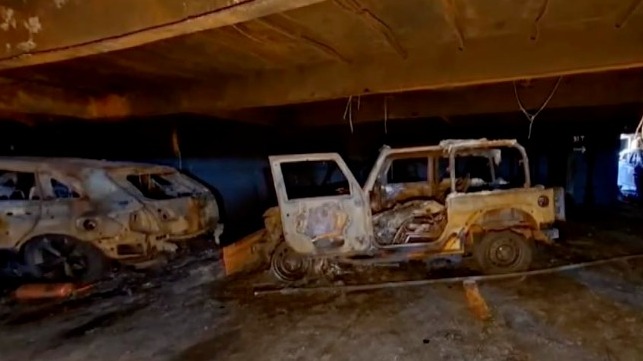"Pusher" Jeep May Have Caused Deadly Ro/Ro Fire in Newark

In a Coast Guard hearing on last year's deadly ro/ro fire at Port Newark, three longshoremen said that their employer used everyday light trucks to push broken cars up the ramps of ro/ro vessels - and that these adapted "pusher vehicles" may not have been maintained on a calendar schedule. The fire aboard the Grande Costa D'Avoria may have started when one of the pusher vehicles - an older Jeep Wrangler fitted with a steel bumper - caught fire during a loading operation.
The ILA longshore duty mechanic on the day of the fire told the panel that there was an informal repair schedule for the pusher vehicles. "We don't have preventive maintenance, we just check fluids, we don't change fluids. It only happens when it goes into the shop for repairs [when something fails]," said Piotr Zyla, who performed basic repairs on the vehicles on the dock for the longshore team.
The Jeep that caught fire had been used in the manner of a towtruck to move cars on board ro/ros, and worked alongside a fleet of several Ford Rangers (the smallest model of Ford pickup). On the day of the fire, longshoreman Gavin Puchinsky was behind the wheel of the Jeep. He told the panel that the Jeep would often be operated with the accelerator pressed all the way to the floor in order to push a heavier broken vehicle up the steep internal ramps of a ro/ro's cargo decks. Though it was the team's most powerful pusher vehicle, the Jeep would sometimes struggle on a ramp, and he might have to back down and get a running start to make it all the way up, he said. The speed of operation would depend upon the weight of the broken vehicle being moved.
In questioning Wednesday, Puchinsky said that the pusher trucks were not the kind of vehicles he would expect to see on a public road. "Some of them were missing mirrors, the Jeep was missing the back windshield, dirty inside, no plates on the vehicle," he told the panel.
The Jeep was running as well as ever until seconds before the fire, when it made a "clunk" as he was maneuvering inside the ro/ro's car decks, Puchinsky said. A few moments later, a fellow longshoreman shouted at him to get out of the vehicle because it was on fire. Flames appeared to be coming from under the hood, Puchinsky said, and were coming in the passenger window.
Puchinsky said that he grabbed a nearby fire extinguisher and attempted to put out the blaze, without success. As the fire grew, he and his colleagues escaped from the vessel.
A local firefighting team responded to the scene and boarded the ship in an attempt to combat the growing blaze. They were forced to retreat by the intensity of the fire, and two were killed during this maneuver. Two Newark Fire captains were also injured in the response and were treated at a local hospital; both recovered from their injuries.
No comments:
Post a Comment